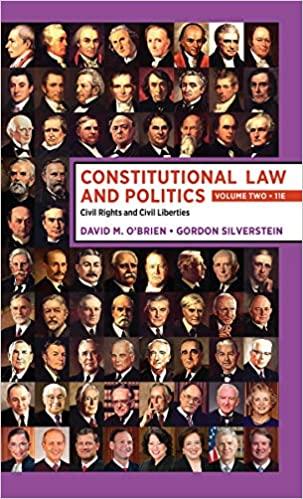Question
Following public concern at the possibility that the government might reduce the availability of jury trials, Parliament enacted the Guarantee of Juries Act 2016 ('the
Following public concern at the possibility that the government might reduce the availability of jury trials, Parliament enacted the Guarantee of Juries Act 2016 ('the GJA') (fictitious) providing that anyone charged with an offence punishable by at least six months' imprisonment was entitled to a trial by jury. Section 12 of the Act further provided that the GJA could only be repealed by a two-thirds majority in both Houses of Parliament.
Following a change of government at a general election, the new government presented the Allocation of Trial Bill to Parliament. Although the Bill was passed by small majorities in both Houses of Parliament, it nevertheless received Royal Assent, thereby becoming the Allocation of Trial Act 2019 ('the ATA') (fictitious). The ATA expressly repeals the GJA, and contains provisions abolishing the right to jury trial for a wide range of offences, including fraud where the amount involved is less than 10,000. The maximum penalty for fraud is ten years' imprisonment.
Shortly after the ATA came into force, Nigel was charged with fraud involving an insurance claim worth 7,500. He asked for a jury trial but, pursuant to the ATA, he was tried at the Cradock Crown Court before a judge sitting on her own. He was convicted and sentenced to two years' imprisonment.
Nigel now seeks to challenge his conviction and has been granted leave to appeal to the Court of Appeal (Criminal Division). He argues that the ATA is invalid and that, in accordance with the GJA, he should have been tried before a jury. The prosecution argues that, pursuant to the doctrine of parliamentary supremacy, the enrolled bill rule precludes any court from investigating the validity of the ATA.
Explain the constitutional principles which are relevant to, and consider the constitutional issues which arise from, the above facts. Advise Nigel whether he has grounds for challenging the validity of the ATA.
Step by Step Solution
There are 3 Steps involved in it
Step: 1

Get Instant Access to Expert-Tailored Solutions
See step-by-step solutions with expert insights and AI powered tools for academic success
Step: 2

Step: 3

Ace Your Homework with AI
Get the answers you need in no time with our AI-driven, step-by-step assistance
Get Started


